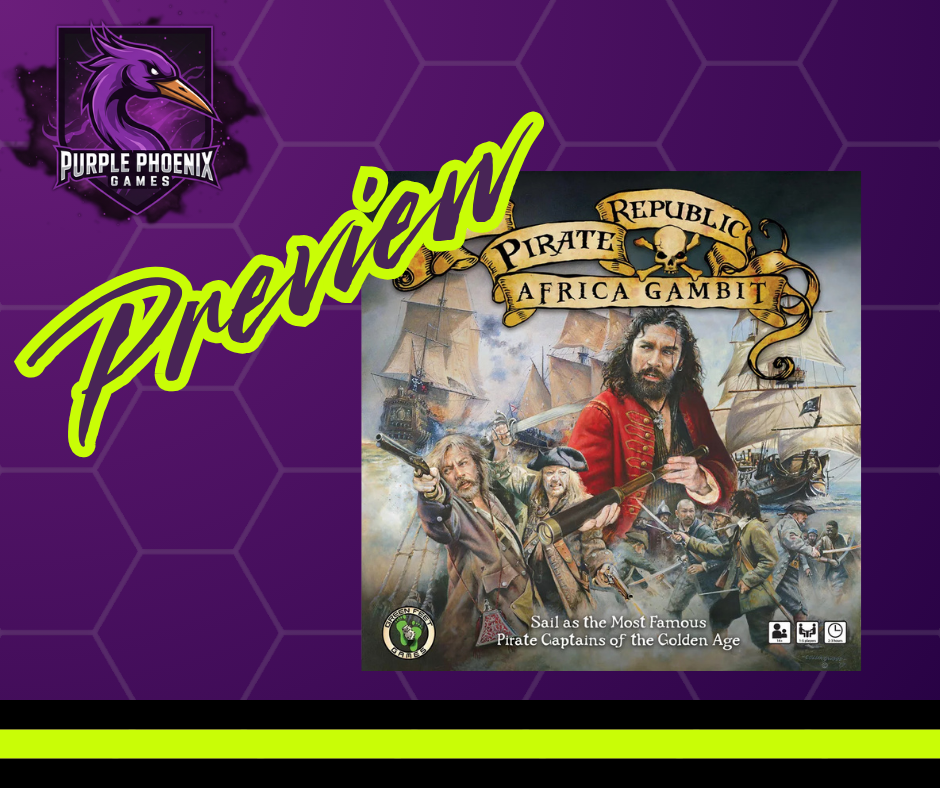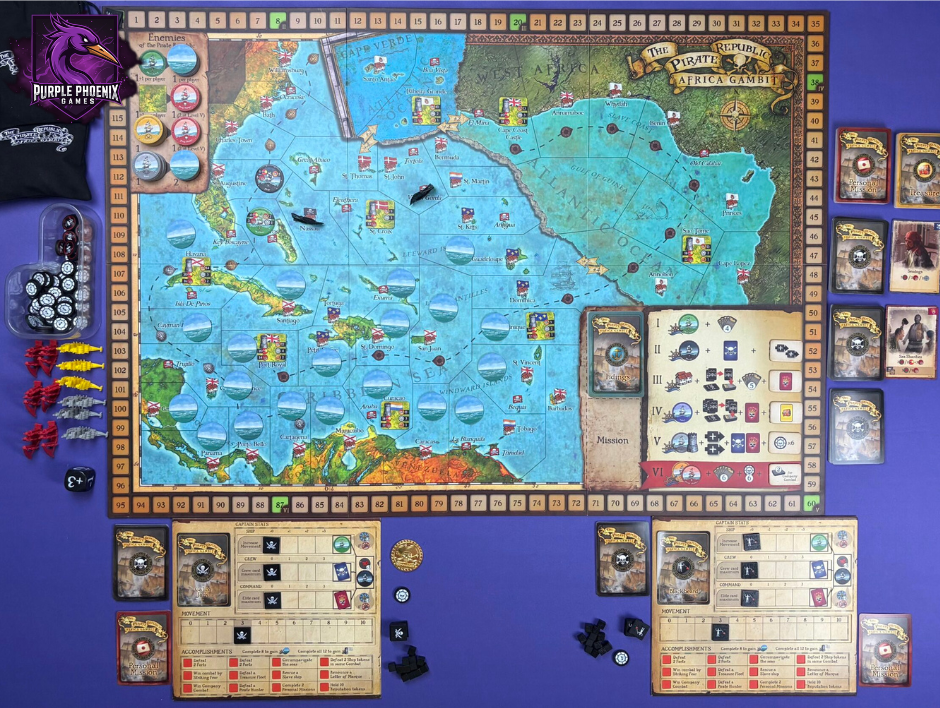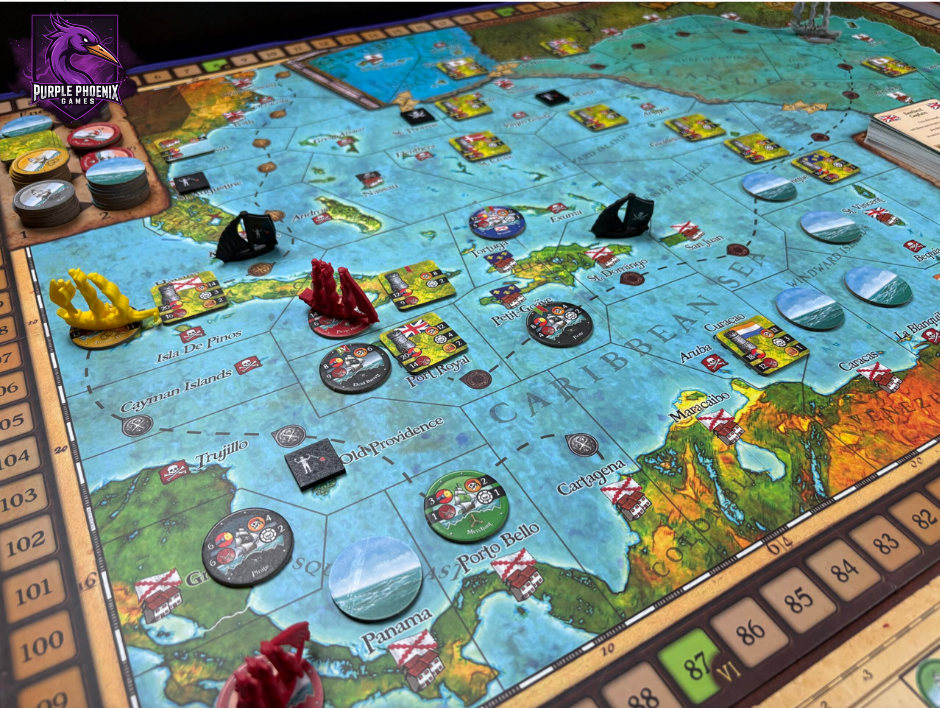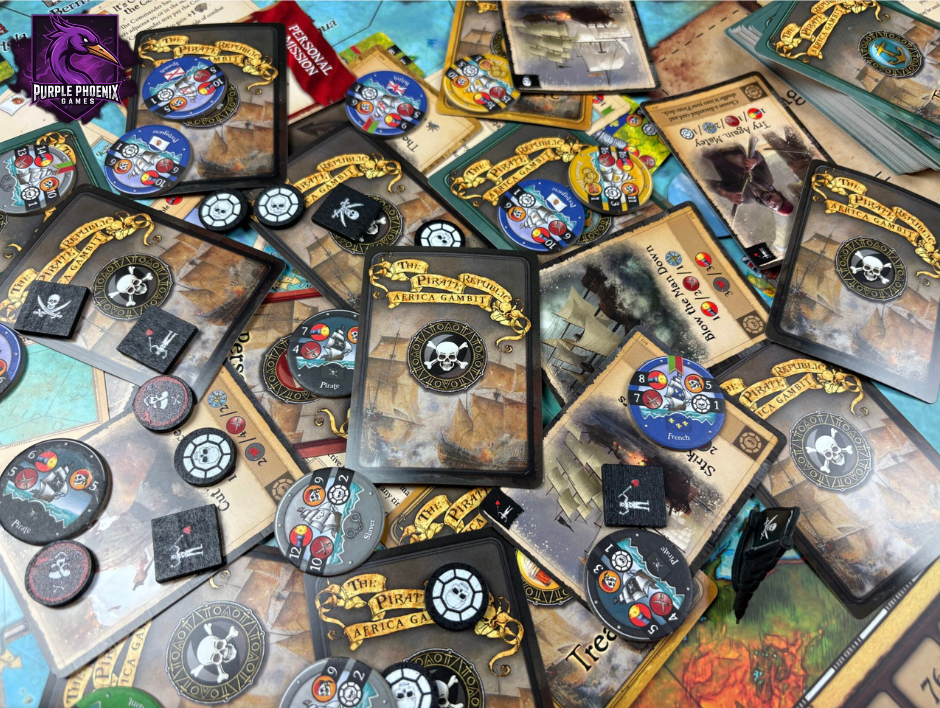
In this day and age, there is no shortage of pirate-themed board games. The real challenge comes in finding one that blends the theme and gameplay into an immersive experience. So when we were given the opportunity to play and preview The Pirate Republic: Africa Gambit, I knew we had to do it. A big ol’ sandbox game that incorporates one of my favorite mechanics (deckbuilding) in a big pirate-themed game? Count me in! Before I officially begin, I do want to mention that The Pirate Republic: Africa Gambit is the second edition to the original The Pirate Republic game. I never played nor have any experience with the original game, so I was coming into this game totally blind.
| The Pirate Republic: Africa Gambit (2025) | Green Feet Games |
| 1-5 Players | 120-180 Minutes |
| Ages 14+ | BGG Weight – Not yet available |
Disclaimer: We were provided with a prototype copy of this game for the purposes of this preview. Some of the components pictured may vary from the finalized production copies. Also, we do not intend to rehash the entire rulebook in this review, but rather provide a general overview of the rules and gameplay. -L
The Pirate Republic: Africa Gambit (simply referred to as Africa Gambit for the remainder of this preview) is a deck-building, sandbox adventure game in which players take on the roles of famous Pirate Captains, leading their crews across the seas, engaging in combat, sacking settlements, and completing missions to amass Swagger amongst the Pirate community. The game can be played as one-off ‘Standard’ games or can be played as a long-term campaign, in which games are connected by a storyline and decisions made in one ‘mission’ can affect you on future missions. For this preview, we played ‘Standard’ games, in which the end-goal is to be the player with the most Swagger Points.
To setup for the game, place the game board in the middle of the table. Choose your Mission Card (no card, in the case of a ‘Standard’ game), and give the Commander token to the first player. Create the stacks of Enemy Ship tokens on the board, as described in the rules, and create a supply of Bloodshed, Reputation, and remaining Ship and Land tokens. Place the Main Forts onto their corresponding spaces on the board, and place out 22 Ship tokens facedown from the supply as described in the rules. Each player is dealt 2 Personal Mission cards, chooses one to keep, and the other is returned to the deck. The Personal Mission and Treasure decks remain facedown, while the Crew and Elite decks are shuffled separately and placed to the side of the board, creating a market of 3 face-up cards from each. Randomly select the Level Reward Tiles and place them in their corresponding spaces on the board.
Each player receives a player board and a ship, markers, cubes, and a deck of cards matching their chosen Pirate. One marker goes onto the Swagger track, 4 go onto the player board to track stats, and the remaining 5 are kept to the side, along with the cubes. Players receive one Reputation token, and place their ship onto any neutral Land site to begin the game. The first player (Commander) chooses an unclaimed Pirate deck and places it to the side, near the Crew and Elite decks, and flips any Ship tokens in their starting and adjacent territories face up. The game is now ready to begin! Pictured below is the setup for a 2-player game.

The game is played over a series of rounds, and each round is broken down into 3 phases: Tidings Phase, Action Phase, and Cleanup Phase. The start of every round begins with the Tidings Phase. First, all players will draw cards into their hand. Everyone starts the game with a hand limit of 4 cards, and everyone’s hand is always public information. So once cards are drawn, lay them out face-up in your play area. Next, the Commander reveals a new Tidings card. Tidings cards are events and effects that will remain in play for the entire round. The Tidings card also indicates the Letter of Marque for the round (more on this later). Finally, any NPC tokens will move at this time. Not all games will have NPC’s, as they are only utilized in certain Global Missions – none are present in a ‘Standard’ game.
The round then moves to the Action Phase, and this is where the crux of the game is played, in turn order. To start each turn, the active player will first roll and resolve the Tidings Die. The Tidings Die can either add or subtract to the player’s movement for this turn, spawn Enemy ships, or spawn/move Treasure or Slave ships. Once the Tidings Die has been resolved, the Actions can begin in earnest. There are 7 Actions available to choose from each turn, and you can take as many of the actions as you wish, in any order, as long as you are able to. The Actions are: Move, Scout, Boast, Combat, Establish a Pirate Haven, Rest, or Declare Infamy. When you choose to Move, you will be sailing your ship from territory to adjacent territory on the board, each costing 1 Movement. Movement is tracked on your player board, and can increase or decrease due to the Tidings Die, cards played, or Level Rewards. If you ever move into a territory with an Aggressive Enemy token, you must immediately begin Combat. An important note – it does not cost Movement to move from the sea area to a land area in your current territory.
Scouting allows you to reveal face-down tokens without having to Combat them. Spend either 1 Reputation token or 3 Movement to reveal a face-down Land token in your current territory, or Ship token in an adjacent territory. In order to use the Boast action, you must be on a pirate-held land area. Spend 1 Reputation token to draw 2 Personal Mission cards, keep one, and return the other to the bottom of the deck. Personal Missions are secret missions for you to perform, and when completed, earn you rewards – most often Swagger and Reputation. Be careful, though, because any Personal Missions you do not complete by the end of the game lose you Swagger! To Establish a Pirate Haven, you must first be on a neutral land area, and spend 1 Reputation to place one of your Pirate markers on the site. Pirate Havens are where you are able to Rest, and you must do so immediately after establishing your haven. You can Rest by playing a card with the effect, or by spending 1 Reputation while on any Pirate Haven. This allows you to discard a Bloodshed token, and either flip a Friendly Ship face-up (more on these in a bit), or take a random card from your discard back into your hand. Declaring Infamy is how you add Elite cards to your deck, or gain extra Reputation. Spend defeated Enemy tokens as Infamy points to draft an Elite card from the market, or take an equal number of Reputation tokens.
The final action option is Combat, and that’s where most of the game is played (in all of my plays, at least). Combat is automatically started anytime you enter a territory or land area that has Aggressive Enemy tokens. Navy Ships, Pirate Ships, Merchant Ships, Pirate Hunters, and any Land tokens are Aggressive, and will begin combat immediately. Treasure Ships, Slave Ships, and Navy Ships that bear the Letter of Marque matching the Tidings Card (same flag) are passive, and do not automatically attack players. During Combat, you will be playing cards from your hand for their various abilities, dependent on the type of combat, who has the initiative, special powers, etc. I won’t get too into the nitty-gritty of it, but the rulebook has a really handy flowchart for the combat resolution order. If you win Combat, you earn Swagger and sometimes Reputation. The player boards have a list of Accomplishments for Combats, and when you complete any, you get to improve one of your stats as well. Improving stats to their max can give you Friendly Ships that can be used to aid you in Combats. Winning Combat with a Land token allows you to place one of your Pirate markers to indicate you have ‘sacked’ it. Losing Combat gives you Bloodshed, and if you ever gain a 2nd Bloodshed token you are considered to be Captured. When Captured, you earn no rewards for the Combat, and must move your Swagger tracker down. So losing a Combat can really hinder your end-game goal.
Your turn ends when you either choose to Rest, choose not to take any more Actions, or are Captured. Draw back up to your hand limit, and reset your Movement tracker. The round moves on to the next player. The round moves to the Cleanup Phase when the Commander needs to draw cards and has no more in their draw pile. All remaining players take one more turn, and then the Cleanup begins. Any cards remaining in hand go into the discard, and discard piles are shuffled to create your new draw pile for the coming round. Discard the current Tidings card, and spawn Enemy Ships if necessary. Discard the Crew and Elite markets, and replenish them with new cards. Give the Commander token to the player with the lowest Swagger score, and the new round is ready to begin. In a ‘Standard’ game, the end-game is triggered when a player has reached 120 Swagger points. Everyone takes one final turn before finalizing scores (subtracting uncompleted Personal Missions if necessary), and the player with the most Swagger is the winner!

As you can probably tell from that rules/gameplay section, this is one meaty game. There’s no BGG Weight yet, but the OG Pirate Republic is rated at 3.12/5, so it’s on the heavier side. This game is a beast – there’s a lot to setup, and a lot of gameplay that will really get your brain burning. That being said, the more plays I get, the more streamlined it feels. As I become familiar with the round structure, actions, iconography, etc., I can feel the game really clicking in my brain. There is a lot of strategy to unpack here. You can’t focus solely on Combat, because for a while your deck won’t be powerful enough to really stand a fighting chance against most Enemies. Personal Missions can be tedious and don’t always offer the most Swagger, but if you don’t complete them by the end of the game, you lose Swagger, so those can’t be ignored once you’ve got them. The Tidings Card each round will often bring a new element into the gameplay that trumps the standard rules, so you must strategize how to maximize those benefits/minimize the consequences with your chosen actions. It is really a big, crunchy, strategic balancing act of tending to all of the elements presented to you. It will really get your brain burning, but with more plays it starts to feel fun and not just overwhelming.
One neat thing I really like about how Combat works in Africa Gambit is that not every combat will necessarily play out the same way. First, you must determine if you have the Initiative or not. Depending on that, you will use different elements from your cards in hand to combat the Enemy token. You must exceed their attack to succeed, but if you have at least half their amount, you take a Bloodshed and can choose to continue fighting, or Flee. That’s a cool twist because it allows you to move away and regroup without having to completely end your turn then and there with defeat. Like I mentioned above, the rulebook has a super handy flowchart of combat resolution that I keep in front of me every game. It takes the crunchiness of the combat mechanic and makes it a bit more concise. Another element that I enjoy about Africa Gambit is the Level Rewards system. As you reach certain points on the Swagger track, you receive bonuses. These bonuses are things like increasing your Hand Size, gaining permanent initiative against certain types of Enemy tokens, drafting Crew or Elite cards to your deck, improving stats, etc. So Swagger not only is how you win the game, but getting Swagger quickly and consistently will get you powerful bonuses!
Let’s touch on components. As I stated earlier, this is not a finalized production version, and there are still some slight changes in the works, but that being said, this is a very well-produced game. For starters, the board is huge and really has that old-time map feel. The Ship and Land tokens are chunky cardboard, and their iconography is clear. The Ship minis look so cool on the board. All of the cards are sturdy, and their artwork is thematic and immersive. Most of the player tokens are wooden instead of cardboard, and that helps elevate the game to a higher level. I love the recessed player boards, and the die is nice and big. And the inclusion of a player reference sheet is a must for a game of this size, as it helps A TON. Green Feet Games has really knocked it out of the park with this game, and my copy isn’t even 100% finalized!
All in all, this is a big game that was kind of intimidating when I first opened it up. With subsequent plays, it’s getting to feel a lot more natural and intuitive. It’s a long game as well, but when I really am getting into it, it feels like the time passes quickly! This game is definitely not for everyone, and not one that I would pull out with every game group. You need a certain kind of gamer for a game of this caliber. Not a knock on this game at all, just something to keep in mind when deciding with whom you can play it. My only ‘complaint’ about this game is that the deckbuilding element moves a little slower than I’d like. You only add a card every so often by getting Swagger or spending Infamy, and those things take a bit of time to acquire. Deckbuilding is there, just not as prominent as I personally would like. Beyond that, though, Green Feet Games has a solid game here. I know there may still be some tweaks here and there, but from what I’ve seen in this prototype copy, it’s a complete package. The Kickstarter campaign is done, but the pledge manager is still open right now! If this game intrigues you, snag a copy before it’s too late!

